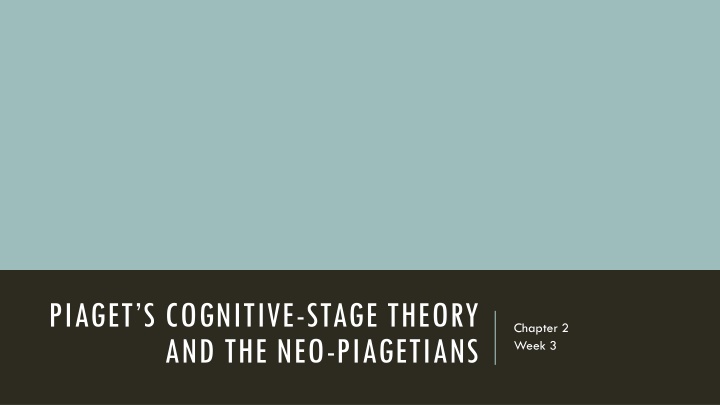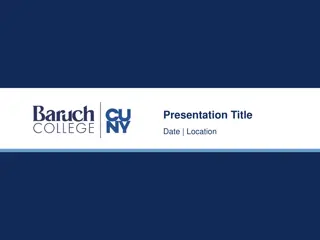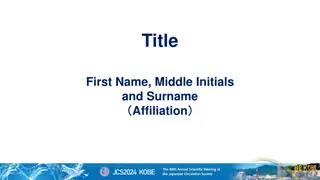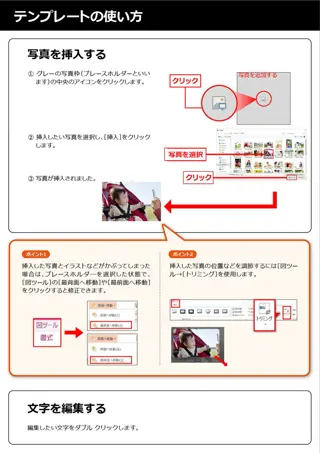
Piaget's Cognitive Stage Theory: Developmental Psychology Insights
Explore Piaget's Cognitive Stage Theory and the Neo-Piagetians in Chapter 2 of Week 3. Delve into Piaget's biographical sketches, general orientation to the theory, methodology, and descriptions of different stages within the theory. Gain a comprehensive understanding of how children actively construct knowledge and progress through various stages from birth to maturity.
Download Presentation

Please find below an Image/Link to download the presentation.
The content on the website is provided AS IS for your information and personal use only. It may not be sold, licensed, or shared on other websites without obtaining consent from the author. If you encounter any issues during the download, it is possible that the publisher has removed the file from their server.
You are allowed to download the files provided on this website for personal or commercial use, subject to the condition that they are used lawfully. All files are the property of their respective owners.
The content on the website is provided AS IS for your information and personal use only. It may not be sold, licensed, or shared on other websites without obtaining consent from the author.
E N D
Presentation Transcript
PIAGETS COGNITIVE-STAGE THEORY AND THE NEO-PIAGETIANS Chapter 2 Week 3
PIAGET The most important figure in developmental psychology Children actively construct knowledge Thinking progress through various stages from birth to maturity
BIOGRAPHICAL SKETCHES 1896-1980, Nueuch tel, Switzerland Family: Turbulent Interests: Wide-range Education: natural sciences (malacology) + psychology and philosophy Research focus: children s thought process psychiatric interviewing technique
GENERAL ORIENTATION TO THE THEORY (1) Genetic Epistemology oThe study of developmental changes in the process of knowing and in the organization of knowledge oExperimental epistemologist oKnowledge is a process people construct knowledge cognitive system develops Biological Approach oCognitive growth adaptation to the environmen
GENERAL ORIENTATION TO THE THEORY (2) Structuralism oThoughts is organized the parts relate to the whole oScheme: an organized partern of behavior reflecting a particular way of interacting with the environment repeatable and generalizable Stage Approach oStage: a period of time during which the child s thinking and behavior in a variety of situations tend to reflect a particular type of underlying mental structure oStructured wholes that emerge from and transform a previous stage, follow an invariant and universal sequence and proceed from an unstable period of transition to a final stable period
METHODOLOGY oClinical method a chainlike verbal interaction oManipulation of objects oObservation
DESCRIPTION OF STAGES (1) Sensorimotor Period (0-2 Years) (1) oStage 1: Modification of Reflexes (0-1 Month) The baby strengthens, generalizes and differentiate behaviors Reflexes Schemes oStage 2: Primary Circular Reaction (1-4 Months) Circular reaction: a behavior is repeated over and over circular Primary: centered on/around the infant s body oStage 3: Secondary Circular Reaction (4-8 Months) Secondary: oriented to the external world Motor recognition
DESCRIPTION OF STAGE (2) Sensorimotor Period (0-2 Years) (2) oStage 4: Coordination of Secondary Schemes (8-12 Months) Combining schemes, including using objects, to achieve goals in new situation oStage 5: Tertiary Circular Reactions (12-18 Months) Active experimentation oStage 6: Invention of New Means through Mental Combination (18-24 Months) The use of symbol to represent objects and events
DESCRIPTION OF STAGE (3) Sensorimotor Period (0-2 Years) (3) Overview oA child: Active learning oCognitive structure: More organized oBehavior: More intentional oSelf: More differentiated Object Permanence oThe object continues to exist even when one cannot see, hear or feel it
DESCRIPTION OF STAGE (4) Preoperational Period (2-7 Years) Mental representations oSymbol and sign oNot yet reversible Characteristics of the period oEgocentrism oRigidity of thought oSemilogical reasoning oLimited social cognition
DESCRIPTION OF STAGE (5) Concrete Operational Period (7-11 Years) oOperation: an internalized mental action that is part of an organized structure oClass oRelation oTemporal-Spatial representations
DESCRIPTION OF STAGE (6) Formal Operational Period (11-15 Years) Mental operations are applied to objects and events operations on operations oScientific method oAbstract ideas oAble to reflect on their own thinking
MEMORY Memory reflects and depends on the entire cognitive strucutre Memory: active understanding Change of cognitive structure change of memory
MECHANISM OF DEVELOPMENT How and why children develop through those stages? Functional invariants: intellectual functons that operate through development oCognitive Organization oThe tendency for thought to consists of systems whose parts are integrated to form a whole oCognitive Adaptation oThe tendency to adapt to the environment oAssimilation: fitting reality into the current cognitive organization oAccomodation: adjusting cognitive organizations due to demands of reality oCognitive Equilibrium oAchieving balance
POSITION ON DEVELOPMENTAL ISSUES Human nature: organismic Qualitative vs. Quantitative Development: qualitative + quantitative Nature vs. Nurture: interactionist Application: readiness
EVALUATION OF THE THEORY Strengths Weaknesses oCognition oStage? oChildren s Thinking oMechanism of Development? oWide scope oPerformance? oEcological Validity oSocial Emotional Aspects? oUnderestimation? oBarriers
THEN WHAT? Piaget s own modification of his theory Neo-Piagetians Active construction stages Constructs The roles of capacity and cultural support in explanations of the variability and consistency of children s thinking Case & Fischer Contemporary Research oInfants advanced competencies oDomain-specific concepts oMechanisms of Development oDevelopmental Cognitive Neuroscience


















